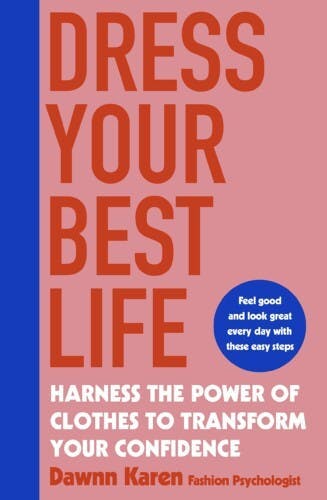Pioneering Fashion Psychology: A Conversation with Dr. Dawnn Karen

Georgia Taylor-Stidwell: For those who do not know, what is fashion psychology?
Dr. Dawnn Karen: Fashion psychology is the study and treatment of how colour, image, style, shape and beauty affects human behaviour while addressing cultural norms and cultural sensitivities.
The practice involves invoking mindfulness and awareness into your daily practice allowing you to better your relationship with your clothing.
G: Why is this link between fashion and psychology beneficial for us to interrogate?
DK: The colours that you choose and the mood that those colours put you in, why you wear something, getting to the root of why you wear something are essential questions to ask yourself. Are you wearing this item to hide yourself, to bury something that you do not want to come to the surface? Are you wearing something to validate someone else? Or are you wearing something to validate yourself? Finding out about clothing as seeking internal or external validation can allow us to think more deeply about what we wear and why. These are ideas I discuss throughout my book ‘Dress Your Best Life: Harness the Power of Clothes To Transform Your Confidence’.

Dress Your Best Life: Harness the Power of Clothes To Transform Your Confidence’.
G: Do you have any advice for those who would like to express themselves through their wardrobes but are struggling? Where can they begin?
DK: This is simple and something I talk about in my book. It all begins with ‘how to have a mindful morning’. Before someone gets out of bed, it is important to do a self reflection and examine how they feel. Often we are on autopilot and we don’t know how we feel unless we are really angry, mad, sad or excited. Beyond these intense emotions we don’t really interrogate how we feel. Having a mindful morning and invoking this mindfulness to determine how you feel and how you want to feel will allow for much more productive dressing. Then you can go to your closet and dress most accurately, according to your mood. Your mental space feeds fashion choices.
G: How can clothing be used to heal? Could you tell us a little about the psychology behind this idea?
DK: It is so similar to a psychiatrist writing a prescription because you are suffering from anxiety. I will write a prescription. For example, I had a client who was a doctor herself, during the pandemic she was suffering from depression on her days off. I was listening to her talking about how some of her patients had died from covid and others were sick, she was afraid for herself and her family. Whilst she was talking to me I noticed that she was wearing her pyjamas. Pyjamas are worn in a calm mood, a lower intensity mood, a sombre mood. If you are already depressed, those pyjamas can take your mood even lower. I asked her how long she had been in the pyjamas, and she said she could not remember. I said you should not be in the same pyjamas for longer than three days, I am going to prescribe you the colour yellow. She is caucasian and these are her words not mine, that she ‘abhors’ the colour yellow because it makes her skin look washed out. However, as I said it was dire straights at this point so I went ahead with the prescription of the colour yellow as a happy colour. I told her, you can wear yellow anything, mask shirt, whatever. Not only did she report that she felt immensely better but it had lifted her up, out of her depression. She reported that her patients who had been seeing her, had also felt good.
G: Could you tell us a little bit about your key concepts ‘Mood Illustration Dress’ and ‘Mood Enhancement Dress’ and why they are so important?
‘Mood Illustration Dress’ and ‘Mood Enhancement Dress’, these are the two concepts which I coined which began the fashion psychology field. As I discuss in my TED talk, I suffered a sexual assault and I knew I had to lift myself up out of the depression and anxiety that I was suffering with at the time. This is when I began Mood Enhancement Dress, aka Dopamine dressing. The concept came about in my research into opioid addiction, I discovered that people are not addicted to the opioids themselves, although they are addictive, they are addicted to the chemical which is released in the brain: Dopamine. I nicknamed Mood Enhancement dress ‘Dopamine Dressing’. I have also nicknamed Mood Illustration Dress ‘Serotonin Dressing’, this is more when you are in a calm state of mind. These concepts are the genesis of the fashion psychology field.
G: Have you experienced issues around being taken seriously in an academic field? Has the traditional link between caring about the way you look and ‘superficiality’ been limiting to your research?
DK: I have experienced many issues being taken seriously, as a black woman and as a young woman. What it took my seniors 20 or even 30 years to do it only took me a matter of 5 years. I am not going to academic conferences and discussing my research with other academics as I do not really see the point as this will keep things circulating only among other academics. The fashion industry needs these ideas, people need these ideas. The fact that I am going to the media as opposed to conferences has been viewed as problematic. I have faced a huge amount of discrimination. I have gone through a lot as a pioneer, but what keeps me going are my students, journalists and my clients. People are interested in what I have to say and offer. It has most certainly been a journey.
Another thing, people do not take me seriously because I am stylish! I have a Fendi hat and a Fendi mask, look at my Birkin bag! Psychology people do not take me seriously and the fashion people think I am too brainy and nerdy. It is two very different worlds and they are hard to combine, it has been problematic but look at me I am still here.
G: You discuss how future oriented your outlook on life is, could you reflect on what you see for the future of fashion and perhaps the future of our relationship with fashion?
DK: I actually expect fashion psychology will have a huge part to play in the future of the fashion industry. I expect every model will have a fashion psychologist, every designer will have a fashion psychologist, every corporation will have a fashion psychologist on their team. I am hoping for the end of 2022 or beginning of 2023 that whilst doing my book tour I am going to be able to licence my curriculum and textbook to universities worldwide. I am also going to come out with a journal ‘The International Journal of the Fashion Psychology Field’. I also have plans to found an association, this would be the International Association of the Fashion Psychology Field, so I really have my work cut out for me!
If you would like more from Dr. Dawnn Karen, make sure to buy her book ‘Dress Your Best Life: Harness the Power of Clothes To Transform Your Confidence’.